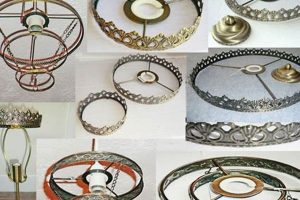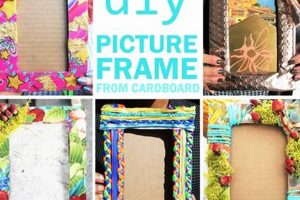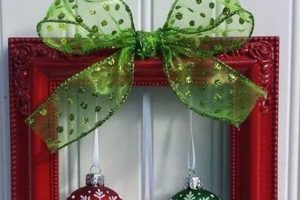The practice involves crafting picture enclosures from a readily available, inexpensive material. This creative endeavor utilizes the structural properties of paper-based boards to provide support and aesthetic enhancement for photographs, artwork, or other displayed items. For example, repurposed packaging can be cut, shaped, and decorated to hold a child’s drawing.
Its significance lies in its accessibility and sustainability. Utilizing recycled materials reduces waste and offers a cost-effective alternative to commercially manufactured picture holders. Historically, resourceful individuals have employed similar techniques to conserve resources and personalize their living spaces. This approach fosters creativity and promotes environmentally conscious practices.
Subsequent sections will detail specific construction methods, decorative techniques, and structural considerations for creating durable and visually appealing displays. The focus will be on providing practical guidance for achieving professional-looking results with minimal resources and skill.
Essential Construction Advice
The following recommendations are provided to ensure a structurally sound and aesthetically pleasing finished product when engaging in the practice of constructing enclosures from paper-based boards.
Tip 1: Material Selection: Prioritize dense, corrugated boards for optimal structural integrity. Avoid thin or damaged boards, as they are prone to bending and tearing. Examine for existing creases or perforations that might weaken the final build.
Tip 2: Precise Cutting: Employ a sharp utility knife and a metal ruler to achieve clean, accurate cuts. Dull blades can lead to ragged edges and inaccurate dimensions. Multiple light passes are preferable to forcing the blade through the material.
Tip 3: Secure Adhesion: Use a strong adhesive, such as a hot glue gun or craft glue, to bond the pieces. Ensure adequate drying time for the adhesive to fully cure before applying weight or pressure.
Tip 4: Reinforcement Techniques: Reinforce corners and edges with additional strips. These provide added stability and prevent separation over time. Consider using corner braces cut from the same material.
Tip 5: Surface Preparation: Prepare the surface for decoration by applying a primer. This creates a smooth base for paint, paper, or other embellishments, ensuring better adhesion and a more uniform finish.
Tip 6: Accurate Measurement: Precise measurements are essential for a well-fitting enclosure. Double-check all dimensions before cutting and assembling to avoid errors that can compromise the overall design.
Tip 7: Protective Backing: Incorporate a backing material to protect the artwork or photograph from dust and damage. Acid-free paper or board is recommended to prevent discoloration over time.
Adhering to these guidelines will enhance the longevity and visual appeal of the crafted display.
The subsequent section will offer guidance on decorating and personalizing the finished build.
1. Material Density
Material density, a crucial physical property, significantly influences the structural performance and longevity of enclosures crafted from paper-based boards. Understanding its implications is essential for producing robust and visually appealing displays.
- Load-Bearing Capacity
Denser boards, possessing a greater mass per unit volume, exhibit a higher load-bearing capacity. This characteristic allows the construction to support heavier artwork or photographs without deformation or collapse. The selection of denser material is paramount when housing items of significant weight.
- Resistance to Bending and Warping
A high density material offers increased resistance to bending and warping under stress. This prevents the frame from distorting over time, maintaining its shape and preserving the integrity of the displayed artwork. Lightweight boards, conversely, are more susceptible to these issues.
- Impact Resistance
Boards with greater density offer improved impact resistance, safeguarding the contents from potential damage. Accidental bumps or minor impacts are less likely to result in cracks or punctures, thereby enhancing the protection afforded to the artwork or photograph housed within.
- Surface Finish Quality
Denser boards typically possess a smoother surface finish, facilitating better adhesion of paints, papers, and other decorative elements. This results in a more professional and aesthetically pleasing final product, as the applied decorations are less likely to peel or bubble.
In summary, material density functions as a key determinant of the finished piece’s durability, protective capabilities, and visual appeal. Careful consideration of this factor is vital for realizing a functional and visually satisfying outcome, directly impacting the usefulness and longevity of the paper-based board enclosure.
2. Cutting Precision
Cutting precision is intrinsically linked to the successful fabrication of picture holders from paper-based boards. The accuracy of cuts directly influences the structural integrity and aesthetic quality of the finished product. Deviations from intended dimensions or angles can lead to misaligned joints, instability, and an unprofessional appearance. For instance, if the corners are not cut at precise 45-degree angles, the resulting structure will not form a perfect rectangle, compromising its ability to securely hold the artwork or photograph and detracting from its visual appeal. In real-world construction, even minor discrepancies in cuts accumulate across multiple pieces, exacerbating alignment issues and potentially rendering the entire assembly unusable.
The practical significance of understanding this connection is multi-faceted. Firstly, accurate cuts minimize material waste. Precise measurements and execution reduce the likelihood of errors that necessitate discarding improperly cut pieces. Secondly, improved precision streamlines the assembly process. Well-cut pieces fit together seamlessly, reducing the need for extensive adjustments or modifications during construction. Finally, higher levels of cutting precision enhance the overall durability of the finished article. Secure, flush joints contribute to a stronger and more stable structure, extending its lifespan and reducing the risk of damage to the artwork or photograph being displayed. Professionals, for example, consistently prioritize cutting precision to guarantee high quality outputs.
In summary, cutting precision is not merely a technical detail but a fundamental prerequisite for achieving a functional and aesthetically pleasing finished article. Challenges in achieving this precision can stem from inadequate tools, insufficient skill, or a lack of attention to detail. However, by emphasizing accurate measurement, employing sharp cutting implements, and maintaining a steady hand, individuals can significantly improve the quality and longevity of their self-made enclosure, ultimately contributing to the preservation and presentation of cherished memories or artistic creations.
3. Adhesive Strength
Adhesive strength represents a critical factor in the structural integrity and longevity of paper-based board enclosures. The efficacy of the adhesive directly impacts the ability of the structure to withstand stress and maintain its form over time.
- Joint Integrity
Adhesive strength directly correlates to the strength of the joints within the structure. A weak adhesive will result in joints that are prone to separation under minimal stress, compromising the overall stability. Real-world examples include corners separating under the weight of the displayed item or edges peeling due to environmental factors.
- Material Compatibility
The choice of adhesive must be compatible with the specific type of paper-based board being used. Certain adhesives may not bond effectively with coated or treated boards, leading to premature failure. Experimentation or research into appropriate adhesives is crucial for ensuring a secure and lasting bond.
- Environmental Resistance
Adhesive strength is influenced by environmental factors such as temperature and humidity. An adhesive that performs well under normal conditions may weaken or fail in environments with high humidity or extreme temperatures. Consideration of the intended environment is essential when selecting an adhesive.
- Curing Time and Method
Proper curing of the adhesive is essential for achieving its maximum strength. Insufficient curing time or inappropriate curing methods can significantly reduce the bond strength. Adhering to the manufacturer’s instructions regarding curing time and method is critical for optimal performance.
In summary, adhesive strength is a paramount consideration. Insufficient bond strength will inevitably lead to structural failure. Through proper selection and application of the adhesive, and careful consideration of material compatibility and environmental factors, a durable and lasting piece is attainable.
4. Reinforcement Strategy
Reinforcement strategy directly impacts the structural integrity and longevity of enclosures constructed from paper-based boards. The inherent fragility of the materials necessitates supplementary measures to withstand stress and prevent deformation. Without strategic reinforcement, the structure is susceptible to bending, tearing, and eventual collapse, rendering it incapable of adequately supporting and protecting its contents. A prime example is the use of corner bracing, where small pieces of paperboard are glued internally to reinforce the mitered corners, areas prone to failure due to the concentration of stress. The practical significance lies in ensuring that the completed unit retains its shape and functionality over an extended period, even under moderate load or environmental changes.
Diverse reinforcement techniques can be employed, tailored to the specific design and intended use of the enclosure. Edge banding, involving the application of strips of thicker paperboard along the exposed edges, provides increased resistance to bending and prevents delamination. Internal supports, such as vertical or horizontal struts, can be incorporated to distribute the weight of the displayed item more evenly, mitigating stress on the outer walls. Furthermore, layering multiple sheets of paperboard and laminating them together significantly enhances the overall strength and rigidity of the structure. Each technique contributes to a more robust and durable final product, enhancing its ability to withstand wear and tear. For example, a larger picture might benefit from both corner bracing and internal supports to prevent sagging in the center.
In conclusion, a well-defined reinforcement strategy is not an optional add-on but a fundamental requirement for the successful construction of durable enclosures from paper-based boards. The selection and application of appropriate reinforcement techniques directly determine the structural stability, longevity, and overall effectiveness. Overlooking this aspect leads to premature failure and compromises the protection afforded to the displayed items. A strategic approach that addresses potential weaknesses ensures the creation of a resilient structure capable of withstanding the rigors of handling and environmental factors, guaranteeing a longer lifespan and maintaining visual appeal.
5. Decorative Surface
The decorative surface is a pivotal component in the crafting of enclosures from paper-based boards, representing the primary means of aesthetic customization and personalization. It transforms a utilitarian structure into a visually engaging display piece, reflecting individual tastes and complementing the artwork or photograph it houses.
- Material Selection
The choice of material for the decorative surface profoundly impacts the final visual impression. Options range from simple applications like paint or colored paper to more elaborate techniques such as fabric covering or mosaic tiling. The selected material influences texture, color, and overall aesthetic style, allowing for a broad spectrum of creative expression. For instance, textured paper emulates the appearance of fabric, or paint replicates different surfaces like wood.
- Application Techniques
The methods employed in applying decorative elements determine the sophistication and durability of the surface. Techniques include painting, decoupage, stamping, and applying adhesive films. Mastery of these techniques is essential to achieving clean lines, uniform coverage, and durable adhesion. Ineffective application can lead to bubbling, peeling, or uneven coloring, detracting from the finished product.
- Surface Protection
A protective layer is crucial for preserving the decorative surface and extending the lifespan of the enclosure. Varnishes, sealants, or laminates provide a barrier against moisture, dust, and physical damage. This protection ensures the colors remain vibrant and the surface remains intact, safeguarding the aesthetic appeal over time. Examples include acrylic sprays that protect painted surfaces or laminate sheets that protect photographic prints.
- Integration with Design
The decorative surface should be seamlessly integrated with the overall design of the display. This involves careful consideration of color palettes, patterns, and textures to create a cohesive visual experience. Incongruous or clashing design elements can detract from the artwork or photograph, undermining the purpose of the enclosure. Consistency in design principles is crucial for achieving a professional and aesthetically pleasing result.
The cumulative effect of these elements is to transform a simple structure into a personalized showcase. A poorly executed decorative surface can diminish the impact of even the most meticulously crafted construction. Therefore, careful consideration of material selection, application techniques, surface protection, and design integration is essential for realizing the full potential of a self-made paper-based board enclosure.
Frequently Asked Questions
The following questions address common concerns and misconceptions associated with the construction of picture holders from recycled materials. These inquiries are answered with a focus on providing clear, concise, and practical information.
Question 1: What types of paper-based boards are suitable for frame construction?
Corrugated cardboard, particularly double-walled varieties, provides substantial structural support. Chipboard, while less robust, is suitable for smaller, lightweight items. The choice depends on the size and weight of the intended display item.
Question 2: How can warping be prevented in large self-made enclosures?
Warping can be mitigated through the application of reinforcement techniques. Internal supports, such as struts or ribs, and the use of thicker materials are effective in maintaining structural integrity and preventing deformation.
Question 3: What adhesives provide the strongest bond for paper-based board construction?
Hot glue, craft glue, and construction adhesives offer reliable adhesion. The selection depends on the porosity of the material and the desired drying time. Proper surface preparation is essential for optimal bonding.
Question 4: How can a professional-looking finish be achieved on a self-made enclosure?
A smooth, even surface can be created by applying a primer before painting or decorating. Multiple thin coats of paint are preferable to a single thick coat. Attention to detail, such as clean edges and precise cuts, contributes to a polished appearance.
Question 5: Is it possible to create a waterproof or water-resistant display from paper-based boards?
While paper-based boards are inherently susceptible to water damage, a degree of water resistance can be achieved through the application of sealants or varnishes. However, prolonged exposure to moisture should be avoided.
Question 6: How can the environmental impact of this construction method be minimized?
Utilizing recycled materials, such as discarded packaging, reduces waste and promotes sustainability. Opting for water-based paints and adhesives minimizes the release of harmful chemicals into the environment.
These questions highlight crucial considerations for achieving successful and sustainable construction outcomes. Addressing these points ensures a more durable and aesthetically pleasing finished product.
The next section will explore advanced design techniques for paper-based board enclosures.
Conclusion
This exploration of the diy frame cardboard practice has highlighted the fundamental aspects of material selection, construction techniques, decorative strategies, and structural reinforcement. Emphasis was placed on achieving durable and aesthetically pleasing results through readily available and often recycled materials. The presented guidelines offer a foundation for creating personalized display solutions at minimal cost.
The information provided serves as a starting point for individuals seeking to engage in this resourceful craft. Practical application of these principles fosters both creative expression and environmental consciousness. Further experimentation and refinement of techniques will undoubtedly yield innovative approaches to the sustainable display of cherished items. The potential for this practice extends beyond mere cost savings; it represents an opportunity to contribute to a circular economy and reduce reliance on mass-produced goods.






![Build a Strong DIY Boxing Bag Frame [Project Guide] The DIY Hub: Creative Crafts, Repairs & Life Hacks Build a Strong DIY Boxing Bag Frame [Project Guide] | The DIY Hub: Creative Crafts, Repairs & Life Hacks](https://craftingdiycenter.com/wp-content/uploads/2025/07/th-2040-300x200.jpg)
